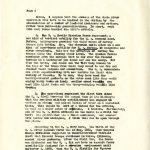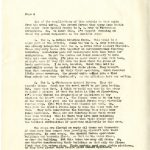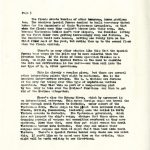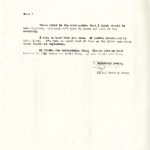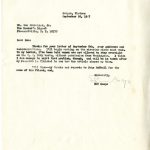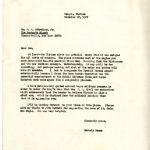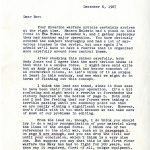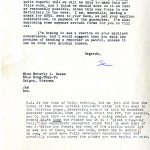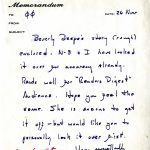1967, August 25, “Outline of Riverine Warfare”
Saigon, Vietnam
August 25, 1967
Mr. S. A. Schreiner, Jr.
The Reader’s Digest
Pleasantville, New York
Dear Sam:
Please excuse my tardiness in getting off to you this outline on riverine warfare; I’ve been up to my ears in Vietnamese politics and election coverage since my return.
For this outline, I prefer not to give an order in which the piece would be put together because, beginning in September, when the rains indulate the Mekong Delta, a series of large-scale, river-borne operations will be mounted. A number of different kinds of units will be involved–U. S.-Vietnamese Special Forces, the U. S. Mobilve Riverine Force, the U. S. Navy coast guard cutters, the Vietnamese naval units carrying regular ARVN troops and paramilitary units. Probably–but not for sure–the Hovercraft “flying boats” will also be backi in Vietnam by that time, and would be included in the operation. The significance of these operations is to sweep and search the swampy Plain of Reeds, which cuts across the Viet Cong-controlled portions of several provinces along the Cambodian border west of Saigon. Hopefully, these operations woud provide at least an action, color lead for the article, if not a major part of the piece itself. But, of course, they could also be a giant fizzle and worth not more than two linens. I would hope, however, to spent quite a bit of time covering these actions for the article.
Aside from the lack of chronology for the outline, this is what I judge to be the significance of the article:
1. The inland water operations by U. S. units have been fairly successful. This is the assessment of the U. S. command here. The trouble is, however, the officials can not articulate or prove it in clear-cut terms. They have bundles of statistics of sampans searched, persons detained and so on; but it’s difficult to weigh these, since obviously they don’t know how many Viet Cong are getting through their river screens and blockades.
Page 2
Hence, I suppose that the success of the whole river operation will have to be implied in the writing by the accumulation of a number of isolated incidents and actions, rather than Delta-wide generalizations. In short, much like Andy Jones handled his SEAL‘s article.
2. 2.The U. S. Movile Riverine Force represents a new kind of tactical mobility for the U. S. command here. Before, helicopters provided the chief means of moving troops into battle. Now, the riverine units usher in a new kind of aqua-borne mobility for U. S. forces. In mangroves nd river swamplands, this has the advantage of moving the troops along the flooded water level. The Special Forces commander gave the example that to fly over the flooded terrain in a helicopter one could not see the eney. But from the boats, one could see the Viet Cong houses in the tops of the trees from which they moved to and fro and stocked their weapons and ammunition. The U. S. commanders are still experimenting with new tactics for their wide variety of vessels. Up to now, they have used the heavily-armored gunboats on the water much like they would employ heavy tanks on land; smaller armed vessleels are used like light tanks and the troop-carrying vesslels like trucks.
3. 3The operations represent the first time since the U. S. Civil War–and the second time in its history–that the American military establishment has engaged in warfare on rivers and inland bodies of water ona sustained basis. This should be sort of a thread for the article, as well as a major point of emhphasis, I believe. Fortunately, one of the U. S. Naval officers in the Delta is a Civil War buff; his grandfather was a Union commander, and somehow with quotes and anaologies, I think this can be spun through the peice.
According to the U. S. Navy here, the birth of the U. S. river assault force was in May, 1861, when General George McClellan suggested to Genera-in-Chief Winfield Scott that Federal troops stationed in Cairo, Illinois, needed river gunboats. AFter the Civil War, the force was disbanded and the U. S. did not have an assault force specifically designed for a reiverine environment until September 1, 1966, when the U. S. flotilla for Vietnam was commissioned.
Page 3
4. 4.While for the U. S. this new type of warfare meas returning to our Civil WAr days, river operations in Vietnam are not new. The Vietnamese Navy has been doing them for years. As a background, rather than as a major portion of the article, I suggest incuding a bit about the Vietnamese River Assault Groups (RAG’s). Like the U. S. Movbile Riverine Force, the RAG‘s are a mini-armada of LCM‘s, which one U. S. officer explained this way: “You remember the pictures of Iwo Jima with the big boats steaming in the distance theand the little boats carrying troops from the big boats to the beaches. Well, here we’re fighting with only those little boats.” Each RAG can carry a battalion of Vietnamese troops into battle and support it with gunfire; in effect, this is a World War II amphibious warfare on a Tom Thumb scale.
We should include the Vietnamese because they do an important part of the river operation–and it’s only fair to give them some credit–but also because they provide an interesting twist to the whole article. From them, the U. S. river-borne untis were copied and Vietnamese Naval advisors were assigned to teach the U. S. Riverine Force while it was in training in California and on its trial operations in Vietnam.
Briefly, the story of the whole riverine concept is this: after World War II, the U. S. gave alot of LCM‘s to the French, who brought them to Vietnam to fight, mostly in the Red River Delta of North Vietnam. The French converted some of these LCM‘s into command ships and into gunboats to protect the other troop-carrying ones. They called these mini-battleships Monitors–no one here knows if they were named after the U. S. CivilWWar vessels or not. Then, when the French pulled out, the turned over their river fleet to the Vietnamese Navy. When American Naval advisors came in the early ’60s, they carried the idea back to the U. S. and from these the U. S. riverine units were formed. Teh U. S. Naval advisors are very humble about admitting that the Vietnamese have taught them more than they taught them in this whole area of operation.
Page 4
One of the complications of this article is that aside from the naval units, the ground forces they carry into battle can alter from Special Forces to U. S. Army to Vietnamese irregulars. So, to limit this, I’d suggest focusing on these two ground components on the American side:
1. The U. S. Mobile Riverine Force. Thsi would be a major part of the article, since the two U. S. Army battalions are already integrated with the U. S. Naval River Assault Flotilla. These ARmy-Navy teams live together on air-conditioned floating barracks. Aqua-borne pads for helicopters have been built for emegencies. To get the quotes and color necessary to make this unit come alive, I’d plan to spend about a week with them, or maybe more if they fit into the lead about the Plain of Reeds operation. I do not, however, think this unit is spectacular enough to sustain the whole piece. They haven’t been that successful. On their first operation, which recieved little press coverage, the ground units watlked into a Viet Cong ambush and were “clobbered”, as the officials here say softly.
2. The U. S.-Vietnamese Special Forces. They are assault troops which use the naval craft to get into battle. But, more than that, I think we could use them in the story to paint a picture of what the Delta is like at flood-time. It’s really beyond the imagination or experience of any American who hasn’t seen it. The floods came up to the tops of the trees last year and the Special Forces camps virtually floated away. (The Viet Cong were flooded out too). So, this year the Special Forces hpe to make the water work for them. They have constructed the floating base camps Andy Jones mentioned. These are not floating bases which carry them into battle; this is where they live once returning from operations. A description of them would itself show the tactical difficulties of operating military in this area.
The camps are floated on empty oil drums and thousands of them have been dumped from low-flying aircraft into their perimeters. IN some camps, the Special Forces operations buildings and barracks float, so that as the water rises, so does the bilding. But this takes too many oil drums. So, now they’re constructing their buildings so that only the floors float when the waters rise. Their mortars need more stable platforms, so they have plaed these inside giant cement cylinders.
Page 5
The floods create bundles of other humorous, human problems too. The American Special Forces decided to build two-story thatch homes for the dependents of their Vietnamese irregulars, so that when the foods came they wouldn’t stream into their camp. But, because Vietnamese babies don’t wear diapers, the families living on the first floor were getting inreasingly damp and furious. So, the Americans built more houses, letting one family live on the first flloor most of the year, but moving them up to the second floor when the floods arrived.
There’s so many other stories like this that the Special Forces base camps in the Delta may be more colorfu than the Riverine Force. If the Plain of Reeds operation fizzles as a lead, we might use the Special Forces as teh lead to describe the life and difficulties in the Delta–and then roll into the new type of U. S. river operations.
This is already a complex piece, but there are several other interesting points that might be mentioned. One is the American inter-servvice rivalry. The U. S. Marines are furious at the Army for taking over this type of amphibious warfare operation. They view this as part of a long-standing plot by the Army to take over the Marines’ functions and then to get rid of the Marines altogether.
There’s also the Mekong River, which by agreement is an international waterway. This means foreign ships can travel the river through South Vietnam to Cambodia, under escort of the Vietnamese Navy. These ships in the pras have included Polish, French, British, Panamanian, incuding some who called in North Vietnam enroute to Cambodia. The Vietnamese government, which does not inspect the ship’s cargo, charges that these crews are dropping parcels of weapons and amumunition overboard as they move upstream. More than that, once they get right across the South Vietnamese border into Cambodia, they stop and unload their cargoes onto sampans and then at night float them back into South Vietnam There’s a Special Forces border camp where one can watch this. If you’d like me to spend more time on the article, this might well be worth waiting to see first-hand.
Page 6
These would be the main points that I think should be investigated, although we’d have to prune out a lot of the paterial.
I hope to hear from you soon. If you’re interested in this piece, I’d want to spend a lot of time on the Delta operation which begins in September.
My thanks for considering this. Please give my best regards to Andy Jones and David Reed, if you should see them.
Sincerely yours,
Bev Deepe
(Miss) Beverly Deepe
The Reader’s Digest
Pleasantville N.Y. 10570
September 8, 1967
Dear Bev,
I enjoyed your long letter about the possibilities of an article on riverine warfare in Vietnam. I can see that the subject is a sprawling and involved one. Nevertheless, we are sure that there is an article there and would like you to go ahead on the same basis as before: i.e., a guarantee of $250. plus expenses.
I have a feeling that you won’t really know what line your article should take until you have done some of the research. It seems to me that there are two possibilites: (1) that you might discover a single individual or single unit whose operations would make a good focus for the whole piece; (2) or that you will find enough unrelated but fascinating bits and pieces to put together an overall gee-whiz look at this type of operation. As of now I tend to favor the latter approach.
I found, for example, the most interesting things in your letter were such items as the fact that this the one area in which the U. S. forces have been taking lessons from the Vietnamese, that this is the first time the U.S. military has been faced with this kind of warfar since the Civil War, and that the Special Forces are building special camps. I find it difficult to see how such varied material can really be worked into the story of a single personality or unit. So perhaps it would be better to address an article to the general proposition that the rivers and the flooding delta area have forced both our forces and the Vietnamese to develop ingenious methods of living and operating. But, I will leave the direction and focus of the piece up to your judgement.
If you like, you might write me again when you have had a chance to cover the story and check out your approach. In any case, I am sure it will work out, and I wish you the best of luck. You might run into
SENIOR EDITOR: S. A. SCHREINER, JR.
Beverly A. Deepe -2- September 8, 1967
or look up a man by the name of Lt. Commander Dan Dagle, who is a friend of John Hubbell‘s. He is somehow involved in this operation, and John says he is a colorful and helpful character.
Regards,
Sam
BEverly A. Deepe
64-A Hont-Thap-Tu
Saigon, VIETNAM
/st
Saigon, Vietnam
September 26, 1967
Mr. Sam Schreiner, Jr.
The Reader’s Digest
Pleasantville, N. Y. 10570
Dear Sam:
Thanks for your letter of September 8th, your guidance and recommendations. I’ll begin working on the riverine piece next week. To my horror, I’ve been told women are not allowed to stay overnight on the U. S. Navy boats, without permission from Washington. I think I can managed to skirt that problem, though, and will be in touch after my research is finished to see how the article shapes up then.
‘Til then–my thanks and regards to John Hubbell for the name of his friend, and,
Sincerely,
Bev Deepe
Bev Deepe
Saigon, Vietnam
November 27, 1967
Mr. S. A. Schreiner, Jr.
The Reader’s Digest
Pleasantview, New York 10570
Dear Sam,
At last–the Vietnam river war article! Sorry that it was delayed for all sorts of reasons. The piece contains most of the angles you were interested in–the American Civil War, learing from the Vietnamese and the new tactical concept. Unfortunatey, it may still be too sprawling, but perhaps wacking out alot of the color and quotes will make it usuable. I had to downgrade the Special Forces aspect substantially because I found the Game Warden Operation was the essential counter-part to the Mobile Riverine Force and hence deserved much more space than I originally planned.
I have deliberately quoted several Negro military persons in order to under the Navy’s fear that the U. S. Civil War connection ight erroneously lead the reader to believe Vietnam is also a civil war, which is distinct from the official American view that it is aggression etc.
I’ll be looking forward to your views on this piece. Please give my thanks to John Hubbell for suggesting the name of Lt. Cmdr. Dan Dagle, who was very helpful.
Sincerely yours,
Beverly Deepe
The Reader’s Digest
Pleasantville, N. Y. 10570
December 6, 1967
Dear Bev:
Your Riverine warfare article certainly arrives at the riht time. Hanson Baldwin had a piece on this force in The Times, December 4, and I gather yesterday they had another major operation. You have obviously covered the subject thoroughly and had a lot of marvelous touches in the script, but once again I’m afraid we’ll have to have a rewrite that is organized more carefully around some central theme.
After studying this rather carefully, both Andy Jones and I agree that the most obvious theme is that this is a unique force. I might have said elite but as Andy points out, that has become somewhat of an overworked cliche, so let’s think of it as unique at least in this century, and see what we might do in terms of fleshing out this concept.
I think the lead can stand, since it does seem to have been their first major operation. It’s a bit confusing and might merit a rewrite to foreshadow the victory reported at the bottom of page 5. Both Andy and I had the feeling that our forces were taking a terrible pasting until you suddenly point out that we are really winning a significant victory. However, don’t fiddle with it too much because we can take care of most of our problems in editing.
From the lead on, though, I do think you should try to do a major reorganization of your material along th elines of the unique force. I think one or two references to the civil war, such as in paragraph 1 and on page 6 are enough, and you can drop the civil war until your conclusion, which I think is a very nice one. But suppose you say that this is the first river warfare the Navy has had to fight for 100 years, and then say it required, first of all, unique equipment, then give us a section on the equipment developed for this fighting.
If the equipment was unique, the men to man it had to be unique as well. Thenis you more or less
SENIOR EDITOR: S. A. SCHREINER, JR.
Page 2
indicate in some of your closeups, such as on En2-Cox but I thin kit could be spelled out in more detail. I have read elsewhere that the personnel of this force are by and large older men compared to the average navy group, and that most of the boat commanders are enlisted men. Couldn’t you brin us closer to the type of men fighting this war? Give us your personal reaction to some of them you met, as compared to the othe rmen in other branches of the service there? Give us anything you might have in the way of color, about the jargon they use, the way they relax, etc. You did say that despite the high casualties they take, these men want to stay in the job. Cox seems to be a good representative figure and perhaps you could focus this section on him.
Given the unique equipment and the unique personnel, we then have a unique arrangement between the ARmy and the Navy in this force. Perhaps a little more could be said about that. Your section on pages 26 and 27 is full of interesting little comments, and I wonder if you could not expand this to include a couple of full-scale anecdotes. I’m sending you a copy of Baldwin‘s column because it indicates that this aspect of the mobile riverine force is regarded as rather important on the command level.
One of your letters indicated that you would not be allowed to go on a patrol, and your manuscript suggests that you were not able to overcome this objection. Andy thinks, and I tend to agree with him, that this element of personal observation of color is missing. He suggests that if it is possible to arrange it in a reasonable time, you might get some man (he mentioned Bob Stokes) to make a quick trip and give you a color report on it. I fyou think this would be helpful or necessary, I’m sure we would be willing to pay a couple of hundred dollars for such a report to be included in your article.
I hop emy concept of reorganizing the material along the lines of the three unique elements involved makes sense to you. I do think it woudl sort out for the reader the various aspects of this type of warfare. If you have a strong feeling that the piece should have some other focus, by all means follow your own inclinations. The main thing is that the finished article be more than simply a good report on this force ( as it is now), that it also prove some thesis that can be stated in or near the lead and retained in the reader’s mind throughout. I think if you will take a look at many Digest articles over the years you will see that this is perhaps the one
Page 3
common element in all of them.
Sorry to gon at this length but I’m really quite hopeful that we will be able to make this article work, and I think we should move on it as fast as reasonably possible, since this new force is now definitely in the news. I am, meanwhile, having a check for $250. sent to your bank, as per your earlier instructions, in payment of the guarantee. I’m also enclosing some expense account forms for you to fill out.
I’m hoping to see a rewrite at your earliest convenience, and I would suggest that yaou skip the problem of sending a reporter on patrol, unless it can be done very quickly indeed.
Regards,
Sam
Miss Beverly A. Deepe
64-A Hong-Thap-Tu
Saigon, Vietnam
/ab
Enc.
P. S. At the risk of being tedious, let me just add that the bones of the above outline shouldn’t stick out too much in the finished piece. Everything should be told by anecdote wherever possible. When you talk about the PBR, for example, you do just that — talk about it. A quick sketch of one patrol might show the reader how it is a “giant ping-pong ball.” [One expository paragraph might tell us what kind of men comprise the force; the rest of the section would let us see one of them, hear him talk, watch him in action.] In sum, we need more fully developed anecdotes that are carefully chosen to carry the points you are trying to make.
R. D.
-check Cuban doctors in VN.,
-River assault.
-Rival Electrifier.
-Agri.
-Some interest in whole POW picture- #28#.- NVA- talk to NVA prisoners.
-Some interest in 5 not villages.
-check any escaped POW’s.- on released ones- or Comm. defectors.
/__. interest in LAD and Thailand.
Check Cuban Exile doctors in VN.-
FORCE PUBLIC AFFAIRS OFFICE
COMMANDER U. S. NAVAL FORCES VIETNAM BOX F
APO SAN FRANCISCO 96214
117 PHAN DINH PHUNG, SAIGON
PHONE: TIGER 3341
Memorandum
TO: Phi Phi DATE:26 Nov
FROM:
SUBJECT:
Beverly Deepe‘s story (rough) enclosed. N-3 and I have looked it over for accuracy already. Reads well for “Readers Digest” Audience. Hope you feel the same. She is anxious to get it off – but would like you to personally look it over first.
Very respectfully
Phi 8
Sounds great.
hope she sells it.
one suggested change V in ilatistics
Read Previous Article: 1967, August 5, “Two-Part Series on Military Situation”
Read Next Article: 1967, September 15, “The Battle of Snoopy’s Nose”


